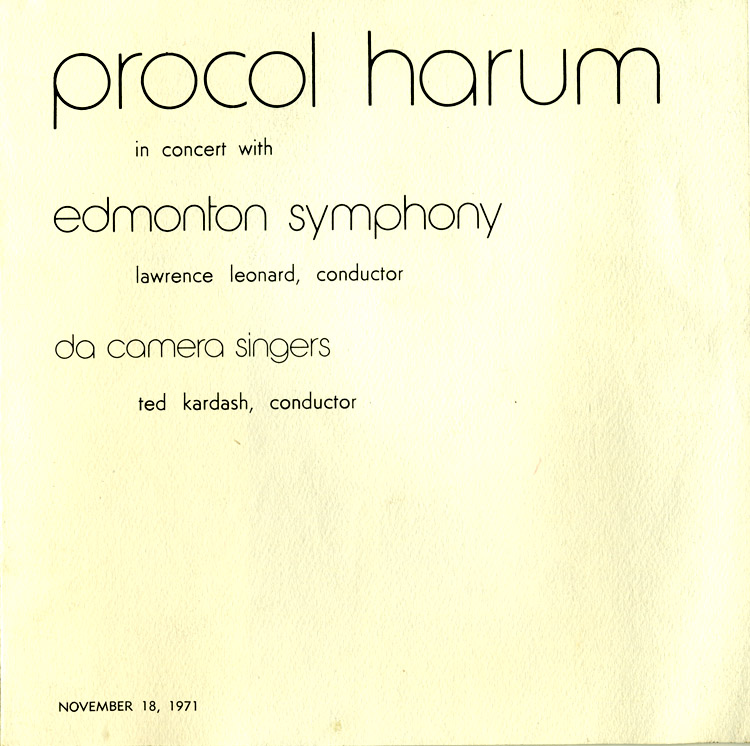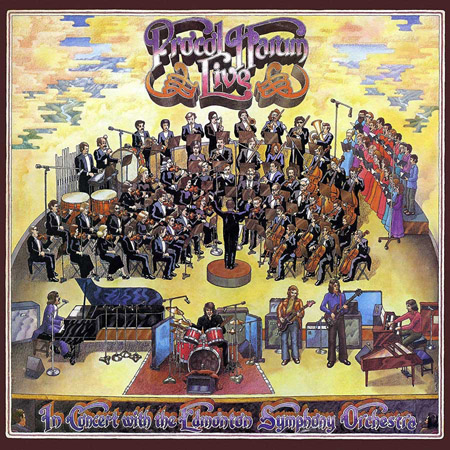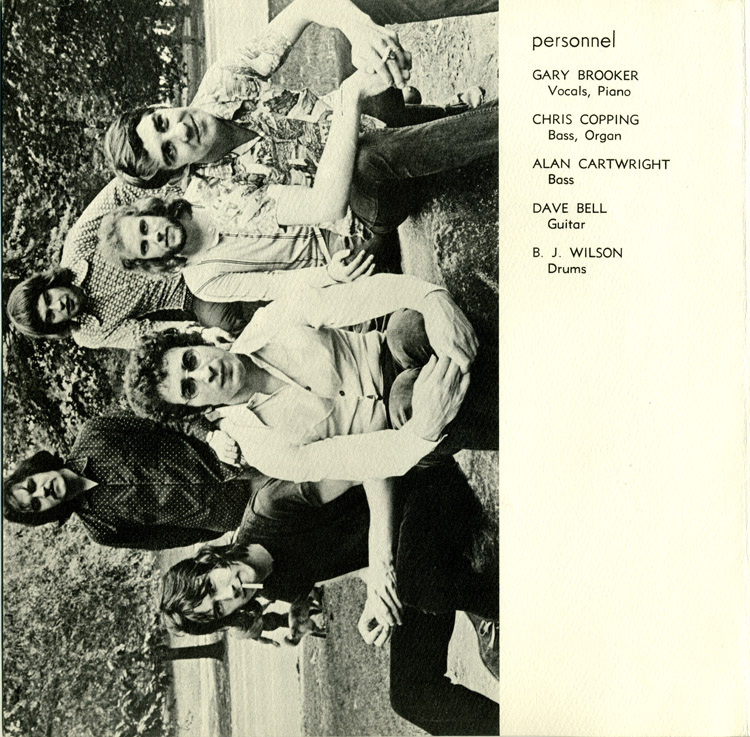Procol
Harum and the ESO: Together Again
Tom Murray in The Edmonton Journal, 9
November 2010
Procol Harum’s experimental gig with ESO in 1971 produced one of the bestselling
discs ever
Procol Harum, the Edmonton Symphony Orchestra and Edmonton’s Da Camera Singers
will close a musical loop tonight and Wednesday (see
here).
For two nights at the Winspear Centre, the three intermittent collaborators will
revisit the songs that put them all on the musical map on 18 November 1971, with
the creation of Procol Harum Live With the Edmonton Symphony Orchestra.
 Singer
and keyboardist Gary Brooker is the only original member of the band left from
the 1971 concert (as well as the 1992 reunion), but Procol Harum is still busily
touring. Its last album came out in 2003, but one is promised for the end of
2010 and the band is in the midst of remastering and re-releasing several older
albums — Grand Hotel, Exotic Birds and Fruit, Procol’s Ninth
and Something Magic.
Singer
and keyboardist Gary Brooker is the only original member of the band left from
the 1971 concert (as well as the 1992 reunion), but Procol Harum is still busily
touring. Its last album came out in 2003, but one is promised for the end of
2010 and the band is in the midst of remastering and re-releasing several older
albums — Grand Hotel, Exotic Birds and Fruit, Procol’s Ninth
and Something Magic.
The 1971 concert at the Jubilee Auditorium gave Procol Harum its most popular
record, but nobody involved was under the impression they were making history.
It was something of a chaotic event, an experiment that shocked everyone
involved when the recording went on to become one of the biggest-selling discs
ever, second only (at the time) to Bing Crosby’s White Christmas. It
revived Procol Harum’s career and put Edmonton on the map.
The orchestra, the choral group and the English progressive rock band have gone
on to other separate triumphs, but they’re inextricably linked in the minds of
many.
There was a two-night reunion May 29 and 30, 1992, with Brooker leading the
recently reunited band back at the Jubilee (Greenwood Singers subbing in for Da
Camera at that time).
The winding road that brought the three original groups to the 1971 concert
makes sense in retrospect. Bob Hunka, who was then assistant general manager of
the ESO, had brought in the popular Canadian group Lighthouse for two successful
nights the year before; Procol Harum boasted a live performance with an
orchestra in Stratford, Ontario, around the same time. Rock bands from the Moody
Blues to Frank Zappa’s Mothers of Invention and the Beatles had begun
experimenting with symphonic elements by the mid-’60s. Procol Harum was intent
on pushing the synthesis.
Brooker and Procol Harum’s road manager Derek Sutton met Hunka at the Edmonton
Inn on 7 August, when the band was in the midst of a North American tour. They
agreed on 18 November as the date for the concert in Edmonton.
Now, as the Winspear hosts the 39th anniversary of the original concert, The
Journal took the opportunity to talk about the seminal 1971 event with some
of those who were there.
Beginnings
Bob Hunka: The day after the second Lighthouse concert, I ran into (ESO board
member) Eric Geddes in the office and he said, “I didn’t know who Lighthouse
were before this, and I’m still not sure that I know who they are now, but
congratulations!”
Petersen [sic]: I was working at the CBC in the summer of ‘71, doing audio,
punching in commercials and watching TV. On came the Elwood Glover show
(Luncheon Date), which was this Canadian institution; Stompin’ Tom got married
on Elwood Glover. Anyways, Procol Harum were on, and they’d just done some dates
with an orchestra in southern Ontario. I perked up and phoned Bob because I knew
he was looking for something after the Lighthouse concerts, and I said, “You
should check them out, because they’ve already got charts.” I don’t think he was
interested.
Hunka: I said no, even after he loaned me all his Procol Harum records to listen
to.
Petersen: The Toronto music writer Ritchie Yorke gave him the same advice, so he
eventually came around to it.
Hunka: The most vivid memory I have of them was when we put it together at the
Edmonton Inn. It was like one of those Judy Garland and Mickey Rooney movies:
“Let’s put on a show!” They had a rock band and I had an orchestra, let’s do it.
Three weeks before it all went down, we got word that they had decided to record
the whole thing, bringing in (legendary American sound engineer) Wally Heider
from LA.
Broddy Olson: Nobody really knew them, but Bob did. I remember Eddy Bayens did a
lot of work with the union for us, so he lined up a flat fee of $280 (per
musician), I think, which was unfortunate, because in the end that album sold
millions. (Other reports put the ESO fee at $5,000.)
Eddy Bayens: It wasn’t as strange as you might think The orchestra was always
open to playing other types of music, not just Shostakovich and Beethoven. We
played what people wanted to hear.
Ron Burrow: I was 19 years old at the time, and just moved from Ontario, where I
had seen (Jimi) Hendrix and the Mariposa Folk Fest. There weren’t a lot of large
bands that came through Edmonton, so when they did, it was an event. It wasn’t
an everyday thing; it was very special. You found out through radio ads and
flyers, not Facebook; we just didn’t have the mass knowledge of events that we
have now.
Bayens: Remember, we were also pretty young, and rock was our music as much as
classical.
Robert de Frece: I was 22, and most of the rest of the choir were in their 30s
and 40s. I was very excited when I was told; the others said, “Who?” and I said,
“This is the band that did Whiter Shade of Pale!”
Burrow: For most people, a rock band would have been Led Zeppelin, or the
Stones, or the Who. Procol Harum, like the Moody Blues, were something
different. They were attempting to do new things with rock music and it wasn’t
for everyone.
Bayens: Procol Harum were very good musicians, and these were good songs, not
just the usual three chord rock.
George Blondheim: I had seen them some time before the ESO concert at the
Kinsmen Field House, and Brooker had done this thing where he started a song
with Bach’s Prelude in C before going into the song itself. We ended up
borrowing that idea for our own band.
Hunka: You’ve probably heard it before, but when they got off the plane, the ink
was still drying on the arrangements that Gary had written.
Petersen: They were around for about four or five days, and I ended up driving
(producer) Chris Thomas around because of my interest in producing. We had a
friend, John Butler, who was a professional chef that happened to be from
England, and he also worked as a driver for the group. One night he invited the
band and crew to come up to his one-bedroom apartment on Jasper Avenue to have
curry. We were all squeezed in there.
Hunka: He was (Edmonton businessman and philanthropist) Sandy Mactaggart’s chef.
The food he made was very exotic to the rest of us; it was the first time I’d
ever had paella.
Rehearsal
 Guitarist
Dave Ball’s amp breaks, and he has to replace it twice.
Guitarist
Dave Ball’s amp breaks, and he has to replace it twice.
Blondheim: I happened to be in Harmony Cats (music store) when the guitarist and
sound guy came by to pick up a new amp, a second amp and a wah-wah pedal, so we
ended up pestering them with questions.
Bill Dimmer: We were a little bit in awe of them, but I also think that they
were a little in awe of the fact that they were onstage with an orchestra.
Olson: Our conductor, Lawrence Leonard, was from England. I think he was kind of
embarrassed to conduct a rock group, because I don’t recall that his name is on
the back of the album.
From Gary Brooker’s notes on the concert: ‘11.15 to 1.15 discussing concert,
particularly the 1st half (which we had not intended to partake in), which ended
in an argument between Lawrence and myself causing him to say he didn’t want to
do the concert and me telling him he needn’t bother.’
Petersen: It was possible that Lawrence Leonard didn’t want his name on the
project because he felt it was going to hurt his career. The band walked into
that situation and it was unfortunate. None of the orchestra guys seemed to have
the same attitude; they were all enjoying themselves. You could say it turned
out truly to have been a bad career move on Leonard’s part.
Hunka: Lawrence agreed to conduct, but actually wanted a guarantee that his name
wouldn’t appear in any reviews. We got along fine, though, and I’m sure he
eventually bonded with his British music mates. I think he maybe had second
thoughts a few years later because of the success of the album.
Dimmer: It was my first year in the orchestra, and I have a strong memory of
Wally Heider and these two trucks’ worth of equipment. There was all of this
gear lying around, a 32-track (some reports say 16) soundboard and microphones
everywhere. I think he was aware of his position, just shouting commands at
people, and the fact that he was kind of in the boonies.
Lois Lund: There were live mikes everywhere, which was a new experience for me.
You couldn’t even sigh without it being picked up. I remember one very tall man
(Procol Harum road manager Derek Sutton) with curly hair down to his shoulders
walking around barefoot.
Bayens: We only had the one rehearsal. It would have been a problem if the
arrangements weren’t good, but these were good arrangements (by Brooker).
Everything fit [sic] like a hand in a glove.
The concert
For participants, this was a nerve-racking experience. The opening act was
sitarist Larry Reese. Before the band came on, Procol Harum organist and
harpsichordist Chris Copping went on alone with the orchestra to perform
Albinoni’s Adagio.
De Frece: I missed the daytime rehearsal because I had to teach, but I was at
this piano rehearsal Da Camera did with Gary Brooker. He had added this speaking
part to a song, and said, “When I say ‘boiling oil and shrieking steam,’ I want
you to go ssssss.” Well, when I got to the show, the other choir members who had
made the day rehearsal told me, “You know how he wants us to go ssssss?’ Well,
you can’t hear anything onstage because it’s so loud; you have to count measures
to know when to do it.” Sure enough, I was ten feet from the band and I couldn’t
hear anything. I was madly counting measures, and poor Lawrence Leonard was just
slightly off; he’d miscounted and you could tell from how he was pursing his
lips when he wanted us to do the part, but we’d done it just before.
 Reese: I stood up to bow (after his performance), not realising my leg had
completely gone asleep from hip to toe, so I fell over and had to limp offstage.
My face was red both with embarrassment and exaltation at having taken part in
this historical rock ‘n’ roll event.
Reese: I stood up to bow (after his performance), not realising my leg had
completely gone asleep from hip to toe, so I fell over and had to limp offstage.
My face was red both with embarrassment and exaltation at having taken part in
this historical rock ‘n’ roll event.
Lund: It was very hard on everyone’s ears. Certainly a symphony is loud, but not
quite as loud as that.
Blondheim: My friend (and then band-mate) Don Johnson got us tickets. It was
such great spectacle.
Petersen: It was kind of an interesting week in Edmonton. Kris Kristoffersen and
Rita Coolidge were in town, and they came to the concert.
Olson: Ed Nixon did the trumpet part in Conquistador (the hit single),
which was very different from what he was used to. He nailed it cold and I
congratulated him on that.
Lunn: We then had to go back out for an awfully long encore to repeat some of
the songs again. It seemed as though we did the concert three times in total.
Afterwards
De Frece: We had a party after. I didn’t get home until 4 in the morning, and I
had to teach in a few hours. I don’t know why, but I hadn’t considered that I
was teaching high school music, and around forty of the kids had been at the
concert. They had seen me onstage in my bubble gum pink shirt with ruffled
sleeves and bell bottom pants and suddenly I was very cool.
Burrow: I went in just wanting to see a rock show, but came out thinking, “Wow,
that was a different approach to bringing two different forms of music
together.” It was revolutionary; my parents’ generation wouldn’t have considered
this to be musical. It took a few years before we realised how historic it was,
of course.
Olson: Later, (ITV general manager) Wendell Wilks and Tommy Banks started the
In Concert series with the ESO, and we’d get people like Tom Jones and
Engelbert Humperdinck in to perform. They came out, found out we were pro, and
after that we did 48 episodes. You’d go anywhere in the world and see Roberta
Flack, Tom Jones or Aretha Franklin and the ESO on television.
Blondheim: I decided after that concert that this was what I wanted to do. It
took some time, because I was self-taught, but I learned to make it happen.
Lund: Every now and again we’d get royalties from that album — not a lot, but it
was still kind of neat that we got anything.
Burrow: I still have a working turntable, so that record does go on from time to
time.
De Frece: I can show people who I am on the album cover — the tall guy with the
curly hair in the ruffled shirt.
Success
According to some reports, Procol Harum had to sell 150,000 copies to break
even.
As they had never sold anywhere near that in their career, they were very
nervous. It went on to sell more than one million copies.
Shine on Brightly,
Luskus Delph, Simple Sister and Repent Walpurgis were also
played, but didn’t make the album, though Luskus Delph was eventually
released.
Procol Harum then: Gary Brooker (piano and vocals), Keith Reid (words), BJ
Wilson (drums), Chris Copping (organ), Alan Cartwright (bass) and Dave Ball
(guitar).
Procol Harum now: Gary Brooker (piano and vocals), Josh Phillips (Hammond
organ), Geoff Whitehorn (guitar and vocals), Geoff Dunn (drums and vocals) and
Matt Pegg (bass and vocals).
Many more pages devoted to the Edmonton
concert
More reviews of the Edmonton album
More reviews of other Procol Harum
albums
 Singer
and keyboardist Gary Brooker is the only original member of the band left from
the 1971 concert (as well as the 1992 reunion), but Procol Harum is still busily
touring. Its last album came out in 2003, but one is promised for the end of
2010 and the band is in the midst of remastering and re-releasing several older
albums — Grand Hotel, Exotic Birds and Fruit, Procol’s Ninth
and Something Magic.
Singer
and keyboardist Gary Brooker is the only original member of the band left from
the 1971 concert (as well as the 1992 reunion), but Procol Harum is still busily
touring. Its last album came out in 2003, but one is promised for the end of
2010 and the band is in the midst of remastering and re-releasing several older
albums — Grand Hotel, Exotic Birds and Fruit, Procol’s Ninth
and Something Magic. 
